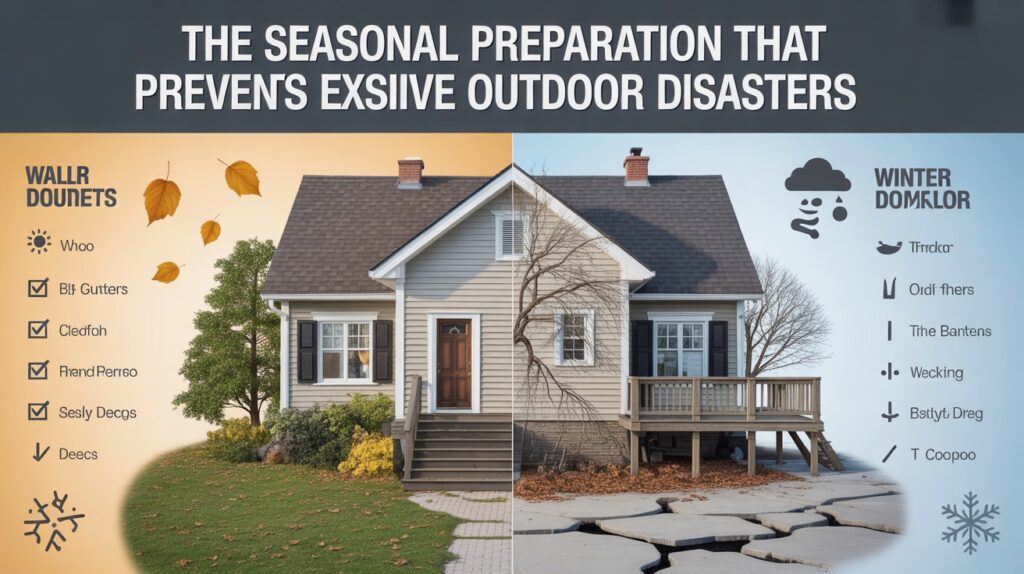Weather doesn’t give advance warning before it hits your outdoor spaces with everything it’s got. One day your garden looks perfect, and the next morning you’re dealing with frozen pipes, flooded patios, or damaged irrigation systems that could have been prevented with some basic preparation. The worst part is that most outdoor disasters happen because property owners skip simple maintenance steps that cost very little but prevent problems that cost thousands to fix.
Seasonal preparation isn’t just about raking leaves or covering outdoor furniture. It’s about protecting the systems and infrastructure that keep outdoor spaces functional and beautiful year-round. The difference between properties that sail through harsh weather and those that get hit with expensive repairs often comes down to whether someone took a few hours to prepare before problems started.
Spring: Getting Systems Back Online
Spring preparation focuses on assessing winter damage and getting water systems operational after months of dormancy. This is when most property owners discover problems that developed over winter – cracked pipes, damaged sprinkler heads, or pump systems that no longer work properly.
Water system startup requires careful attention to avoid costly mistakes. Turning on irrigation systems too quickly can cause pipe bursts in lines that may have shifted or cracked during freeze cycles. The smart approach involves gradual system activation, checking each zone individually before running full cycles.
For properties with well water systems, spring represents a critical maintenance window. Winter conditions can affect pump performance, pressure tanks, and electrical connections in ways that aren’t immediately obvious. Professional shallow well pump installation includes winterization features that protect pumps from freeze damage, but annual maintenance ensures these systems continue operating reliably through changing weather conditions.
Drainage systems need attention after winter as well. Gutters, downspouts, and yard drainage can get clogged with debris that accumulated during winter months. Clearing these systems before spring rains arrive prevents water damage to foundations, basements, and landscaping.
Summer: Protecting Against Heat and Storms
Summer preparation involves protecting outdoor systems from extreme heat and sudden storm damage. High temperatures can stress irrigation systems, electrical components, and plant materials in ways that create expensive problems if not addressed proactively.
Irrigation system efficiency becomes critical during hot weather when water demands peak. Systems that waste water through leaks, misaligned sprinkler heads, or poor programming can drive up utility bills and stress municipal water supplies. Regular system checks during early summer identify problems before they become expensive during peak usage periods.
Electrical systems in outdoor spaces face particular challenges during summer storms. Lightning, high winds, and heavy rainfall can damage outdoor lighting, pump systems, and irrigation controllers. Installing proper surge protection and ensuring electrical connections are weatherproof prevents storm damage that often requires complete system replacement.
Plant protection strategies also affect long-term maintenance costs. Proper mulching, efficient watering schedules, and strategic shade placement reduce stress on both plants and irrigation systems during extreme heat periods.
Fall: Preparing for Winter Shutdown
Fall preparation focuses on protecting outdoor systems from freeze damage and preparing for winter dormancy periods. This is when proper preparation makes the biggest difference in preventing expensive spring repairs.
Irrigation system winterization prevents the most common cause of expensive spring repairs – frozen pipes and components. Water left in irrigation lines expands when it freezes, cracking pipes, fittings, and sprinkler heads. Professional winterization involves draining all water from the system using compressed air to ensure complete water removal from underground lines.
Outdoor plumbing requires similar attention. Hose bibs, outdoor sinks, and water features need proper drainage and insulation to prevent freeze damage. The cost of freeze protection is minimal compared to the expense of repairing burst pipes and water damage.
Pool and water feature preparation prevents both freeze damage and equipment problems that develop during shutdown periods. Proper chemical balancing, equipment winterization, and cover installation protect expensive pool systems and reduce spring startup costs.
Winter: Monitoring and Emergency Prevention
Winter maintenance involves monitoring outdoor systems and responding quickly to weather emergencies that threaten property infrastructure. Even properly winterized systems can face challenges from extreme weather conditions that exceed normal preparation measures.
Snow and ice removal protects both plant materials and hardscaping from damage. Heavy snow loads can break tree branches that damage roofing, vehicles, and other property. Ice formation can damage concrete, stone, and other hardscaping materials through freeze-thaw cycles.
Emergency response planning becomes important when winter weather threatens outdoor infrastructure. Knowing how to shut off water systems, protect exposed pipes, and clear drainage systems can prevent minor weather events from becoming major property disasters.
Equipment storage and protection during winter months extends the life of seasonal tools and systems. Proper storage prevents corrosion, freeze damage, and deterioration that requires expensive replacement or repair.
The Economics of Prevention
The financial benefits of seasonal preparation become clear when comparing prevention costs with emergency repair expenses. A few hundred dollars spent on system maintenance and winterization can prevent thousands in emergency repairs and system replacement costs.
Insurance considerations also favor proactive maintenance. Many policies require proper maintenance and winterization to cover weather-related damage claims. Properties with documented maintenance records often receive better claim treatment than those without evidence of proper preparation.
Property value protection represents another economic benefit of seasonal preparation. Well-maintained outdoor systems and spaces contribute to property values, while neglected systems can reduce marketability and require expensive updates during property sales.
The key to successful seasonal preparation is treating it as an ongoing investment in property protection rather than just annual maintenance tasks. Properties that maintain consistent preparation schedules avoid the expensive emergency repairs that affect properties where maintenance gets deferred or skipped entirely.

